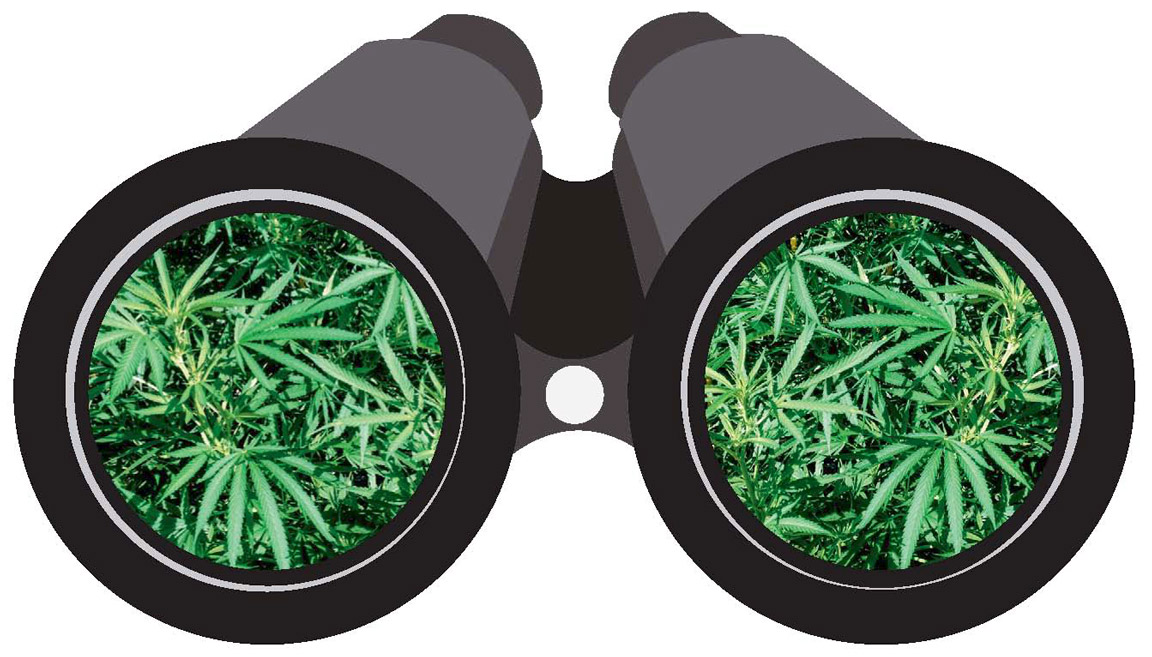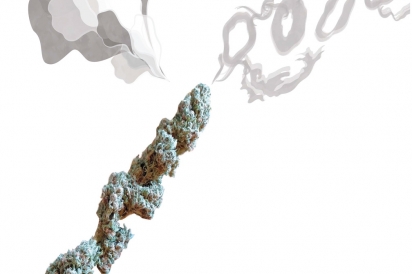Dreaming of Blue
A quest in search of a particular high
The glass jar was empty of everything but a fine dust and I was beginning to feel anxious. I made the requisite phone calls to providers, both legal and not so much. No dice.
My favorite strain of green bud had been sold out for many weeks, and the new harvest was months away. The only remaining remedy was to go to the source: a pilgrimage to an agricultural shrine found on a rough and tumble patch of land in Northern California.
The old wagon was loaded with a few days’ worth of provisions: cheese, yogurt, smoked trout and cured ham, tomatoes and peppers pulled warm from the garden, wine and Amaro, olive oil and salt. Three fingers of magazines, books, knives, bathing suits, hiking boots and an old yellow Lab named Haas were all tucked in, too. This was no Saturday morning trip to Washington Square Park for a dime bag.
We pointed the navigational to the tie-dye and flannel region of Anderson Valley, in western Mendocino County. Along with wild fungi, age-worthy Pinot Noir and un-oaked Chardonnay, ancient redwood forests, crystal and rock shops and decades-old apple orchards, the area also produces some of the finest marijuana in the world.
In truth, I’ve smoked grass most of my adult life. Some people take pharma; some drink alcohol; some climb mountains. I smoke grass, which I do enjoy. I always have.
God, I always have.
Immediately the smoke makes me rise to a level of awakened contentment, of well-being; a cat with a full belly lying in the afternoon sun.
As with all rites that win over heart and mind, my relationship with dope can be deeply ambiguous, the rare morning’s battle fought over a tiny cigarette of grass. While the daily ritual of a couple (or three) glasses of wine with dinner has been relinquished, I do smoke with some frequency. But when its utility finally peaks, offering only diminishing returns, my headspace veiled in the gauze of a cheap nightgown, I cleanse myself.
There’s also a high in sobriety.
But this is not one of those moments, and what I now seek is a blast of creative enlightenment, not through just any old street-skunk, eighth-of-an-ounce ganja, but rather the nonpareil strain: Blue Dream.
The two predominant species of the cannabis plant, Cannabis indica and Cannabis sativa, are both psychoactive varieties inducing unique highs. When crossed, they create different hybrid strains bred for specific traits such as levels of potency, disease resistance, flowering cycles, THC ratios. The abbreviation THC stands for tetrahydrocannabinol, which provides the psychoactive whoosh of marijuana, and is also prescribed to affect pain, hunger and depression.
The indica and sativa species and their strains have differing characteristics, smells and tastes, and produce effects particular to that smoke. Indica plants are short and stocky, fast to flower (within 45–60 days), and respond well to being grown inside. Indica strains, such as OG Kush, Northern Lights, Buddha’s Sister and Yumbolt, originally hail from India and central Asia. Their buds are thick and heavy, with sweetish- sour aromas reminiscent of a Jewish deli on a cold Sunday morning: yeasty dough, brined pickles, honeyed baklava, sour tomatoes. Indica produces a stony body high. Muscles relax and a sense of thickness permeates the physical being. Also mentally soothing, indicas are often smoked at night to induce sleep, and used to relieve body pain, spasms, anxiety and headaches.
But it is the sativa strain for which I jones. Sativa plants are well suited to being grown outside, their long, leafy stalks and branches towering to 25 feet. Requiring a whopping 60–90 days of nurturing sun to flower, this strain was originally tended in the equatorial climes of Jamaica, Mexico, Thailand and southern India. Sativa buds are often larger than those of indica, but less dense and, unfortunately for the grower, therefore not as weighty. Given sativa’s lower grow weights and longer time to flower, it’s consistently in high demand.
As opposed to indica’s body high, sativa produces a more energetic, uplifting and cerebral high best suited to creative, daytime endeavors. Sativa varieties such as Willie Nelson, Lamb’s Bread and Allen Wrench are also used by medical marijuana patients to fight depression; toking to a sense of well-being. Sativa’s fragrance is the essence of green: pine needles, sage, wet conifer, Jasmine Pearl green tea, peppermint.
The entry to the long, winding dirt drive was difficult to locate, and the gardens were set a fair distance from the main road. Sequestered from prying eyes in different valleys at varying altitudes, the gardens were laid with rows of “smart pots,” each accommodating 400 pounds of soil, a mulch of rice straw and the fully mature plant. The copious amounts of water needed to feed the giant ganja spring from a recently dug well that’s gravity fed from tank to tank and from garden to garden, the aquatic feeding tubes meandering all the way down the rocky mountainside.
A family friend, the maestro of this semi-clandestine pop-up farm, is a young vegan yogi who studies permaculture and ecological design. His tanned and filthy bare feet are caked with the dry dirt of drought-ridden summers. Clothed only in stained red running shorts falling from his thin frame, he proudly walked us through the gardens, a cloud of dust trailing him like a Charles Schultz character.
Blue Dream, a cross of 80% sativa (haze strain) with 20% indica (blueberry strain), is the only strain produced at the farm, a thoroughbred in a grower’s horticultural stable of high horses. Grown outside under the summer sun, the plants are fed an organic diet of bat guano from Oregon, kelp from the nearby Mendocino coast, a special blend of phosphates and minerals, and compost tea.
Cannabis plants produce nodes along their stems, from which grow leaves, branches and flowers (the buds). The cola is the site from where the buds sprout, the largest always situated at the top of the plant, the crown on a green queen. The large verdant leaves flashing in the sun are unsurprisingly familiar: the leaf emblazoned on posters, beach towels and T-shirts around the world. Ironically, these fan-shaped leaves contain very little THC and smoke like your first-ever drag off a stale cigarette.
The plants sported a few hairs, or trichomes, sprouting from the stem leaves and the pistils were the reddish blond of an Irish setter, an indicator of the presence of THC. It was, however, the warm sun and heady aromas of water, mineral, earth and flowering green bud wafting in the afternoon breeze that made me excitedly high.
And nothing had even yet been lit.
Perhaps I was expecting a Napa Valley with guns. There was, however, nothing manicured about the place. Planted amidst a young forest punctuated with palm trees, the farm felt more jungle than organized agriculture. The occasional whirr of DEA helicopters overhead was disconcerting; a musical crescendo to living on the periphery. Indeed, there was a wild-west vibe to the operation, albeit one with great ecological consciousness.
While many growers—the ones doing it legally, anyway—appear more concerned with poachers than with law enforcement, sheeting the size of billboards laid next to each garden displaying a California-issued license grow number did little to alleviate feelings of shadiness and illegality.
But as noted by a certain gravelly voiced, Nobel Prize–winning writer, the times, they are a-changin’.
As of 2017, 26 states and the District of Columbia have passed laws broadly legalizing marijuana in some form, and three other states will soon join them after recently passing measures permitting medical marijuana. Seven states plus the District of Columbia include the recreational use of marijuana. Here at home, the passing of California’s Proposition 64 allows adults (21 and older) to possess up to one ounce of marijuana and grow up to six plants in their home.
After being gifted the last two large buds of Blue Dream from the previous harvest, we drove from Anderson Valley’s hot floor to the cool of our rented cottage atop a forested mountain. From the porch, we watched the fog shuffle in from the Mendocino coast slowly and determinedly, an old lady making her way home. The cackle from crows perched overhead in old-growth redwoods and throaty, amorous calls from the bullfrogs in the pond below introduced the cool of early evening.
Two king-sized rolling papers were glued together and the fragrant bud was finely ground in a stone mortar and pestle found in a kitchen cupboard. With a nod of gratitude to Greek deities Demeter, goddess of earth and agriculture, and Dionysus, lover of fruitfulness and ecstasy, we took couple of puffs. Its headiness was quite sufficient to send us giddily into nearby orchards, now overgrown with Asian and Bartlett pears, ambrosial Clingstone peaches and a half-dozen varieties of apples.
Pot does make one hungry. Studies suggest marijuana triggers the hypothalamus region of the forebrain, which helps control body temperature, thirst, hunger, sleep and emotional activity. But satisfying the munchies no longer means a stack of Pringles paired with a can of Coke to combat cottonmouth.
Sitting in silence under a darkening sky, we ate pears baked with butter, maple syrup, nutmeg and a good douse of the local Germain-Robin brandy; each withered pear topped with a scoop of fresh, soft cheese from Pennyroyal Farmstead, whose goats roam the neighboring hills.
Ah, yes, that advertised feeling of peace, contentment and well-being. Indeed, Anderson Valley is the stuff of dreams.
Blue dreams.






